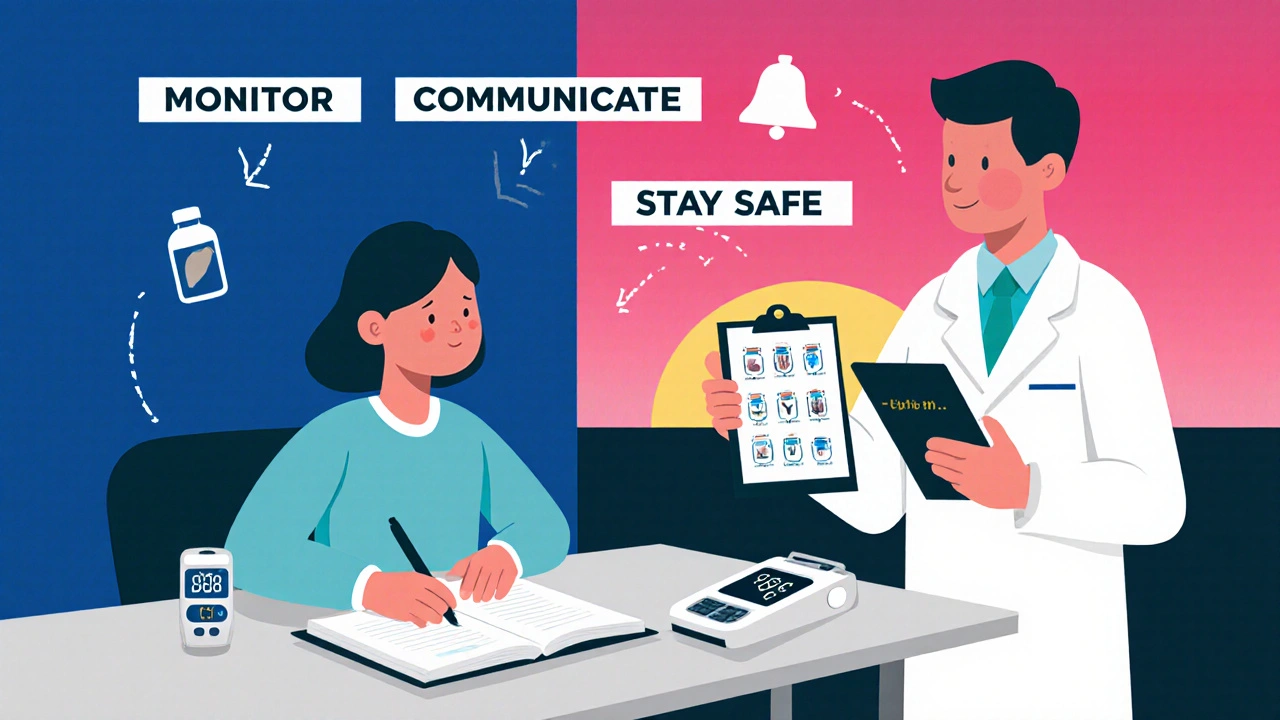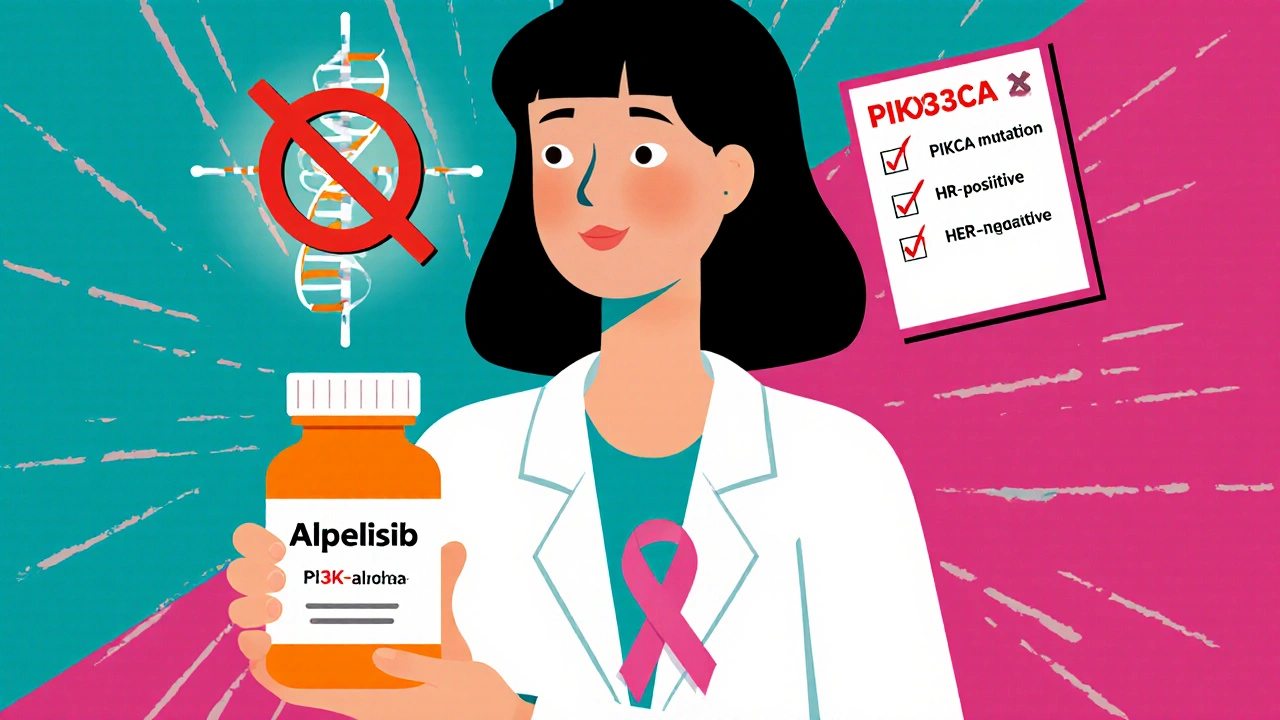Blood Sugar Monitoring Tool
Blood Sugar Assessment
Check your current fasting blood sugar level against safety guidelines for alpelisib treatment.
Quick Takeaways
- Alpelisib is a targeted therapy for certain advanced breast cancers with a PIK3CA mutation.
- Most patients experience skin rash, high blood sugar, or diarrhea - often within the first two months.
- Blood tests before and during treatment help catch hyperglycemia early.
- Dose reductions or temporary stops can manage many side effects without losing effectiveness.
- Never start or stop alpelisib without talking to your oncology team.
What Is Alpelisib?
When you first hear the name Alpelisib is a selective PI3K‑alpha inhibitor that blocks a key growth signal in cancer cells. It was approved by the FDA in 2019 for adults with hormone‑receptor‑positive, HER2‑negative breast cancer that carries a PIK3CA mutation. By shutting down that pathway, alpelisib can slow tumor growth when used together with endocrine therapy such as fulvestrant.
Who Should Take Alpelisib?
The drug is prescribed for patients with metastatic or locally advanced breast cancer that tests positive for a PIK3CA mutation. The mutation occurs in about 40 % of HR‑positive, HER2‑negative tumors, so a genetic test is required before starting treatment. If you have diabetes or pre‑diabetes, your doctor will weigh the risks because alpelisib can raise blood‑sugar levels.
Common Side Effects and Their Frequency
| Side Effect | Any Grade (%) | Grade 3 or Higher (%) |
|---|---|---|
| Rash | 64 | 32 |
| Hyperglycemia | 48 | 20 |
| Diarrhea | 45 | 14 |
| Nausea | 38 | 5 |
| Fatigue | 32 | 3 |
These numbers come from the pivotal SOLAR‑1 clinical trial, which enrolled over 500 patients. "Any grade" includes mild symptoms that you might notice at home, while "Grade 3 or higher" represents severe reactions that usually need medical intervention.
Managing the Most Common Side Effects
Rash-Most rashes appear as red patches or itchy bumps. Over‑the‑counter hydrocortisone cream and antihistamines can calm mild cases. If the rash spreads quickly or involves blisters, call your oncologist - they may pause the medication and prescribe a prescription‑strength steroid.
High Blood Sugar-Alpelisib can push glucose levels up by 30 % or more. If you already have diabetes, check your blood sugar twice daily for the first month. Your doctor might add or adjust metformin or another oral agent. For patients without diabetes, a single episode of hyperglycemia often resolves after a dose reduction.
Diarrhea-Stay hydrated and consider an over‑the‑counter anti‑diarrheal like loperamide. If stools are watery for more than three days, or you notice blood, it’s time to contact your care team.
Other bothersome symptoms such as nausea or fatigue usually improve after the first treatment cycle. Eating small, frequent meals and getting gentle exercise can help.
Monitoring and Lab Tests
Before you start alpelisib, doctors will order baseline labs: fasting glucose, HbA1c, liver enzymes, and a complete blood count. After the first two weeks, repeat glucose and liver tests are typical. If everything looks stable, labs are checked every 4-6 weeks.
Keep a medication journal. Write down the date and time of each dose, any new symptoms, and your blood‑sugar readings. Having a clear record speeds up the conversation with your oncologist when adjustments are needed.

Drug Interactions and Precautions
Alpelisib is metabolized mostly by the CYP3A4 enzyme. Strong CYP3A4 inhibitors (such as ketoconazole or clarithromycin) can raise alpelisib levels and increase toxicity. Conversely, strong inducers (like rifampin) may lower drug exposure and reduce effectiveness. Always share your full medication list, including over‑the‑counter supplements, with your health team.
Pregnant or breastfeeding people should avoid alpelisib - the drug can harm a developing fetus. Effective contraception is required during treatment and for at least one month after the last dose.
When to Call Your Doctor
- Rash covering more than 30 % of your body or with swelling, blisters, or fever.
- Fasting glucose above 200 mg/dL on two consecutive days.
- Diarrhea lasting longer than three days despite OTC meds.
- Severe nausea that prevents you from keeping food down.
- Any new symptom that feels out of the ordinary.
Early communication helps keep you on therapy while minimizing discomfort.
Frequently Asked Questions
How long does a typical alpelisib course last?
Patients stay on alpelisib until the disease progresses or side effects become unmanageable. In trials, the median treatment duration was about 10 months.
Can alpelisib be taken with other cancer drugs?
Yes - the label authorizes alpelisib with fulvestrant for hormone‑receptor‑positive disease. Combining it with chemotherapy or other targeted agents is not recommended without a clinical trial setting.
What should I do if I miss a dose?
Take the missed tablet as soon as you remember, unless it’s less than 8 hours before the next scheduled dose. In that case, skip the missed one and continue with your regular timing.
Is alpelisib covered by insurance?
Most major insurers cover alpelisib for the FDA‑approved indication, but prior authorization is common. Your oncology office can help submit the required paperwork.
Can I continue my regular diet while on alpelisib?
A balanced diet low in simple sugars helps control blood‑sugar spikes. If you have severe hyperglycemia, a nutritionist may recommend a carbohydrate‑controlled plan.
Understanding alpelisib’s safety profile empowers you to spot problems early and work with your care team on solutions. With diligent monitoring and a proactive approach to side‑effect management, many patients stay on therapy long enough to see a real benefit against their cancer.


Kirsten Youtsey
October 20, 2025 AT 21:55One must appreciate the nuanced pharmacodynamics of alpelisib, yet the lay summaries conveniently gloss over the insidious potential for metabolic derangement. It is almost as if the manufacturers conspire to downplay hyperglycemia, a fact that the discerning reader cannot ignore. The rash incidence, while statistically reported, hides a spectrum of dermatologic trauma that most patients are unprepared for. In short, the safety profile is a carefully curated narrative, not an objective truth.
Matthew Hall
October 28, 2025 AT 23:55Man, this alpelisbig thing is like a roller‑coaster of skin eruptions and sugar spikes – you never know when the next drama will hit. Everyone talks about the numbers but forgets the sleepless nights watching glucose charts like a horror movie. I swear they hide the worst side effects behind glossy brochures, feeding us a false sense of calm. The whole thing feels like a secret plot to keep us guessing.
Vijaypal Yadav
November 6, 2025 AT 02:55Alpelisib’s mechanism hinges on selective inhibition of the PI3K‑alpha isoform, which directly attenuates downstream AKT signaling. The associated hyperglycemia arises from hepatic gluconeogenesis unopposed by insulin signaling. Clinical trials stratified patients based on baseline HbA1c to mitigate confounding metabolic variables. Consequently, the adverse event profile aligns with the drug’s intended molecular target.
Ron Lanham
November 14, 2025 AT 05:55It is incumbent upon every patient and caregiver to recognize that the therapeutic promise of alpelisib does not absolve us from a moral duty to scrutinize its collateral damage. When a medication routinely induces rash in two‑thirds of recipients, we must ask whether the benefits truly outweigh the suffering inflicted upon the skin, an organ we rarely consider in ethical calculations. Furthermore, the elevation of blood glucose in nearly half of all users is not a trivial laboratory anomaly but a harbinger of long‑term metabolic disease. To ignore such data would be tantamount to endorsing an exploitative practice that places profit above patient dignity. The clinical community bears responsibility to demand transparent labeling that does more than list percentages in a sterile table. Patients deserve concrete guidance on how to adjust diet, monitor glucose, and seek timely intervention without fearing dismissal. A failure to provide such support implicitly sanctions a culture of neglect that erodes trust in oncologic care. Moreover, the reliance on dose reductions as a catch‑all remedy obscures the deeper issue of whether the drug’s dosing paradigm is fundamentally sound. If a therapy cannot be administered at its approved dose without precipitating severe adverse events, we must reconsider its place in the treatment algorithm. The ethical imperative extends to insurance providers who, by imposing prior authorizations, often delay access to essential supportive medications. Such bureaucratic obstacles can exacerbate hyperglycemia, turning a manageable side effect into a life‑threatening crisis. In addition, the omission of comprehensive counseling on potential rash management in the prescribing information betrays a disregard for holistic patient care. Healthcare professionals must proactively educate patients on the use of corticosteroid creams, antihistamines, and when to pause therapy. Equally important is the responsibility to coordinate with endocrinologists at the first sign of glucose dysregulation. Only through an interdisciplinary approach can we hope to preserve quality of life while pursuing oncologic control. In sum, the safety profile of alpelisib is a reminder that scientific advancement must be tempered by unwavering ethical vigilance.
jessie cole
November 22, 2025 AT 08:55Remember, you are not alone in this journey. Keep a daily log of your doses and any symptoms, it will empower your doctor to make quick adjustments. If a rash appears, apply a gentle hydrocortisone cream and let your care team know right away. Staying proactive can make the difference between staying on treatment and having to stop.
Deja Scott
November 30, 2025 AT 11:55Cultural humility reminds us to listen to each patient’s story.
Natalie Morgan
December 8, 2025 AT 14:55The alpelisib regimen calls for vigilant glucose monitoring and prompt rash care to avoid complications. A balanced diet low in simple sugars supports metabolic stability. Simple lifestyle tweaks can reduce the burden of side effects. Consistency in lab checks guides clinicians in timely dose modifications. Maintaining open dialogue with your oncology team fosters confidence.
Mahesh Upadhyay
December 16, 2025 AT 17:55The drama of alpelisib lies in its dual edge – tumor control versus relentless skin fire. Yet we must not excuse the suffering for a clinical endpoint. A concise plan of action saves lives and sanity. Stand firm on demanding clear side‑effect protocols. Morality demands accountability.
Rajesh Myadam
December 24, 2025 AT 20:55I hear how overwhelming the constant monitoring can feel, and that’s completely understandable. Taking extra blood‑sugar checks can seem like a punishment, but it’s a safeguard for your wellbeing. If the rash becomes uncomfortable, reaching out early can prevent escalation. You deserve a treatment plan that respects both efficacy and quality of life.